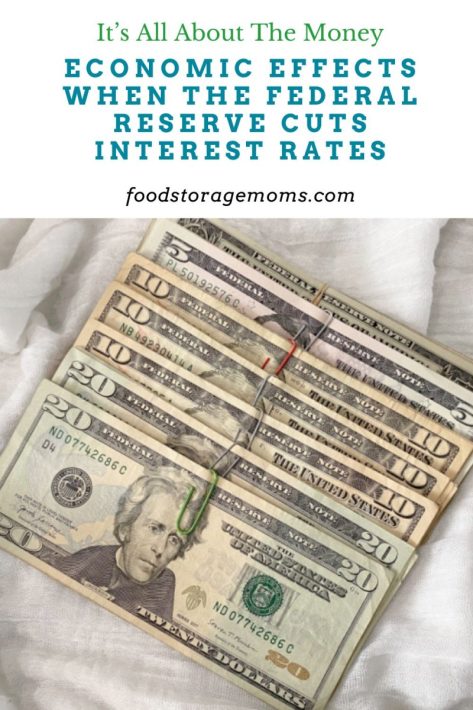When the Federal Reserve cuts rates of interest, it has wide-reaching results throughout the U.S. financial system and even globally. Right here’s a transparent breakdown of what usually occurs:
What It Means When the Fed Cuts Charges
The Federal Reserve lowers the federal funds fee, which is the speed at which banks lend to at least one one other in a single day. This impacts borrowing prices throughout the financial system, together with mortgages, automobile loans, enterprise loans, and bank cards, which are likely to comply with swimsuit.


Quick-Time period Financial Results
1. Cheaper Borrowing
- Customers and companies can borrow cash at decrease rates of interest.
- This typically boosts spending, funding, and house shopping for.
- Bank card rates of interest may drop barely, releasing up disposable revenue.
2. Inventory Market Increase
- Decrease charges make bonds much less enticing, so buyers typically transfer cash into shares.
- Companies profit from decrease financing prices, doubtlessly enhancing income and driving market rallies.
3. Weaker U.S. Greenback
- Decrease rates of interest usually scale back the worth of the U.S. greenback relative to different currencies.
- This may make exports cheaper and extra aggressive overseas, serving to U.S. producers.
Medium-Time period Results
1. Elevated Shopper Spending
- Decrease mortgage prices encourage spending on big-ticket objects like houses, vehicles, and home equipment.
- This may stimulate GDP progress, particularly in consumer-driven sectors.
2. Enterprise Enlargement
- Corporations could use cheaper credit score to increase operations, rent extra staff, and improve manufacturing.
- This may scale back unemployment and lift wages over time.
3. Rising Inflation
- With extra money flowing by means of the financial system, demand can outpace provide, pushing costs increased.
- If inflation rises too shortly, the Fed may later reverse course and lift charges once more.
Lengthy-Time period Dangers and Facet Results
1. Asset Bubbles
- Extended low charges may cause overvaluation in actual property or inventory markets, growing the chance of future crashes.
2. Decreased Financial savings Returns
- Decrease rates of interest imply decrease yields on financial savings accounts, CDs, and bonds.
- Retirees and conservative buyers could earn much less on their financial savings.
3. Debt Progress
- Simpler credit score circumstances can result in increased family and company debt, which turns into dangerous if charges rise later.
World Results
- Different nations could reduce their charges to maintain their currencies from rising in opposition to the greenback.
- Rising markets can see capital inflows as buyers search increased returns overseas.
- Decrease U.S. charges can relieve strain on international debt, particularly for nations that borrow in {dollars}.
Are We Overdue For A Housing Correction
Quick reply: Most likely not an enormous nationwide crash proper now, however a modest cooling or localized corrections are possible in markets that ran hottest. Under, I clarify why, what might change that, and the important thing numbers to observe.
Fast proof guidelines
- Costs are nonetheless up modestly yr over yr (not exploding). The Case-Shiller nationwide index and FHFA each present small constructive positive factors fairly than runaway progress. FRED+1
- The inventory of houses has risen, and the months-of-supply is again towards extra regular ranges (NAR stories ~4.6 months of provide), which eases upward worth strain. That provides consumers extra alternative and cools bidding wars. Nationwide Affiliation of REALTORS®
- Mortgage charges have fallen from their 2025 peak however stay elevated vs. pre-pandemic (30-yr ~6.2% lately), so affordability continues to be constrained, and plenty of consumers stay cautious. Decrease charges are serving to exercise, however consumers are ready for extra exact fee cuts. Freddie Mac+1
- Lending is way tighter than in 2006, family leverage is more healthy, and delinquency alerts should not exhibiting the identical degree of stress that preceded the final crash, so systemic danger is decrease. (A number of market stories & analysts notice low likelihood of a 2008-style crash.) S&P World+1
What “overdue for a correction” normally means (and why we’re not there)
A broad, quick correction implies giant destructive shocks (a pointy leap in unemployment or rates of interest), widespread borrower misery, and excessive leverage/debt. At the moment, now we have solely a type of drivers intermittently (interest-rate sensitivity). Costs rose much less in 2024–2025 than throughout the pandemic increase, provide has slowly normalized, and mortgage underwriting is way stricter, which reduces the chance of a sudden, deep nationwide crash. FHFA.gov+1
The place corrections are most probably
- Overheated Solar Belt or Mountain States markets that noticed vital pandemic positive factors and now have rising stock could expertise localized worth pullbacks of 5–10%.
- Areas depending on a single employer/business if that sector weakens (tech layoffs, power shocks).
- New builds in markets with overbuilding can face bigger markdowns if demand softens.
Eventualities that might set off an even bigger nationwide correction
- A sudden, deep recession with giant job losses and mortgage delinquencies.
- Mortgage charges re-spiking above earlier highs (if inflation surprises on the upside).
- A pointy drop in investor demand has beforehand helped sure markets.
Sensible takeaway / what to observe (5 indicators)
- 30-yr mortgage fee: an enormous spike again above ~7.5% would materially reduce affordability. Freddie Mac+1
- Months of stock (NAR): sustained rise above 6 months nationally factors to purchaser’s market circumstances. Nationwide Affiliation of REALTORS®
- Case-Shiller & FHFA: sustained destructive YoY readings for a number of months sign broader worth declines. FRED+1
- Unemployment & layoffs: fast will increase would precede increased delinquency and compelled gross sales.
- Mortgage delinquency charges: rising delinquencies are an early purple flag for misery.
Backside line
A modest correction or plateau is the most probably near-term consequence: costs easing, extra stock, fewer bidding wars, and regional variation. A nationwide crash like 2008 is unlikely right now until an sudden, extreme financial shock happens. When you’re a purchaser, watch charges and stock; when you’re a vendor, be reasonable about pricing in markets the place stock and days-on-market have already elevated.
U.S. Housing Market — Regional Overview (Fall 2025)
1. Solar Belt (Texas, Florida, Arizona, Nevada)
- Development: Costs have flattened or dipped barely (–2% to –5% YoY in some metros).
- Purpose: Oversupply of recent building, increased insurance coverage prices, and migration leveling off.
- Examples:
- Austin, TX, and Phoenix, AZ, present delicate corrections after big pandemic positive factors.
- Tampa and Orlando, FL, stay robust however slower than 2022–23 ranges.
- Outlook: Steady-to-soft market; good for consumers in search of offers.
2. West Coast (California, Washington, Oregon)
- Development: Blended coastal cities stabilizing; inland areas cooling.
- Examples:
- San Francisco and Seattle noticed small rebounds in early 2025 however at the moment are flat.
- Sacramento and Portland present slight declines resulting from affordability limits.
- Outlook: Balanced market; not crashing however nonetheless costly.
3. Northeast (New York, New Jersey, Massachusetts, Pennsylvania)
- Development: Barely rising costs (+2–4% YoY).
- Purpose: Restricted stock, robust job markets, and decrease new building.
- Examples:
- Boston and New York suburbs proceed to draw demand.
- Outlook: Strong, with few indicators of correction resulting from tight provide.
4. Midwest (Ohio, Michigan, Illinois, Indiana)
- Development: Regular progress (+3–5% YoY).
- Purpose: Affordability and powerful native economies.
- Examples:
- Cleveland, Kansas Metropolis, and Indianapolis stay undervalued in comparison with coastal areas.
- Outlook: Resilient area; least more likely to see a correction.
5. Mountain West (Utah, Idaho, Colorado)
- Development: Gentle correction (–3% to –6%) after pandemic surges.
- Examples:
- Boise and Salt Lake Metropolis cooled sharply from 2021 highs.
- Denver stays regular however with slower gross sales.
- Outlook: Continued softening by means of early 2026 earlier than stabilizing.
6. Southeast (Carolinas, Georgia, Tennessee)
- Development: Nonetheless rising however slowing (+1–3% YoY).
- Examples:
- Charlotte and Atlanta present reasonable appreciation; Nashville is flattening.
- Outlook: A reasonable correction is feasible in overbuilt areas, however demand stays robust resulting from migration.
7. Mountain & Rural Markets
- Development: Declines as much as 8% in trip or remote-work-driven increase cities.
- Purpose: Demand pullback as distant work stabilizes.
- Outlook: Longer adjustment interval.
Abstract Desk
| Area | 2025 Value Development | Danger of Correction | Foremost Drivers |
|---|---|---|---|
| Solar Belt | –2% to –5% | Medium | Oversupply, affordability |
| West Coast | 0% to +2% | Low-Medium | Affordability, job markets |
| Northeast | +2% to +4% | Low | Tight provide |
| Midwest | +3% to +5% | Low | Affordability, regular demand |
| Mountain West | –3% to –6% | Medium | Pandemic surge cooling |
| Southeast | +1% to +3% | Low-Medium | Migration, restricted stock |
| Rural / Trip | –5% to –8% | Excessive | Distant-work reversal |
Remaining Phrase
When the Federal Reserve cuts rates of interest, it’s normally making an attempt to stimulate financial progress, combat unemployment, or stop a recession. Whereas the transfer typically boosts spending and funding within the quick time period, it carries longer-term dangers, similar to inflation and market imbalances, if maintained for too lengthy.
We’re seeing a regional rebalancing, not a nationwide crash. The Midwest and Northeast are nonetheless appreciating modestly, whereas the Solar Belt and Mountain areas are working by means of minor corrections after outsized progress. Could God bless this world, Linda


